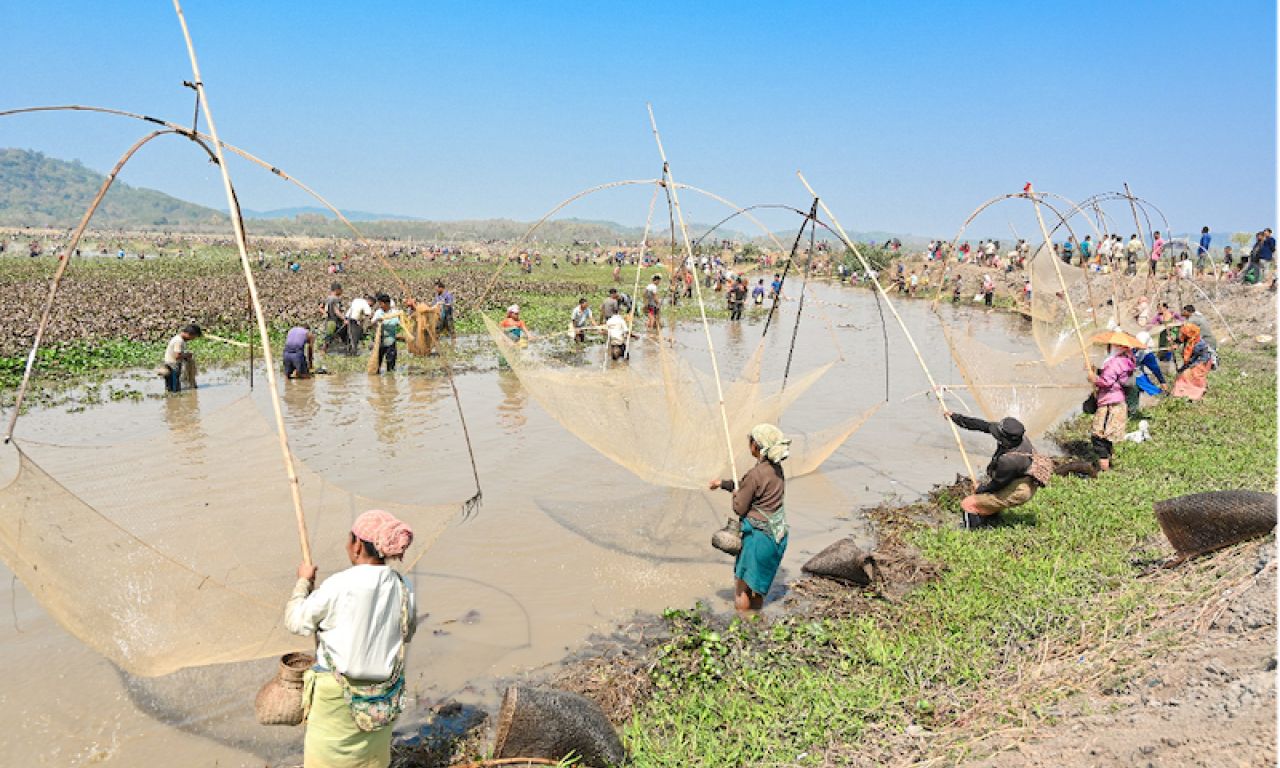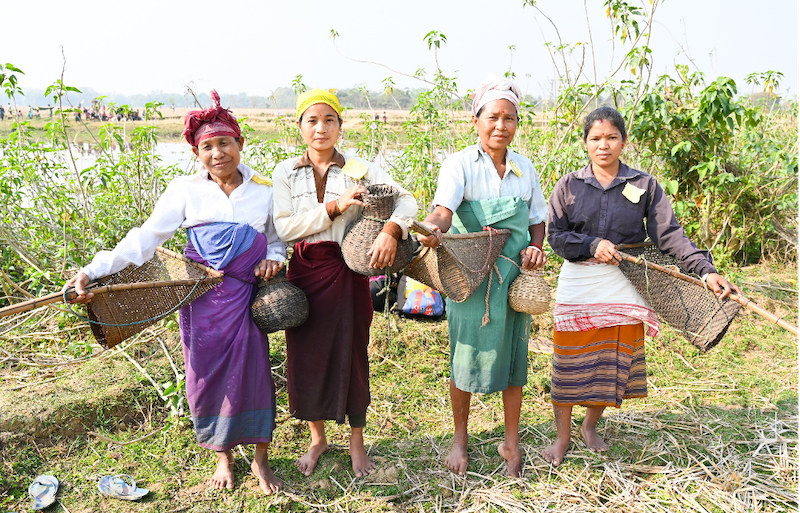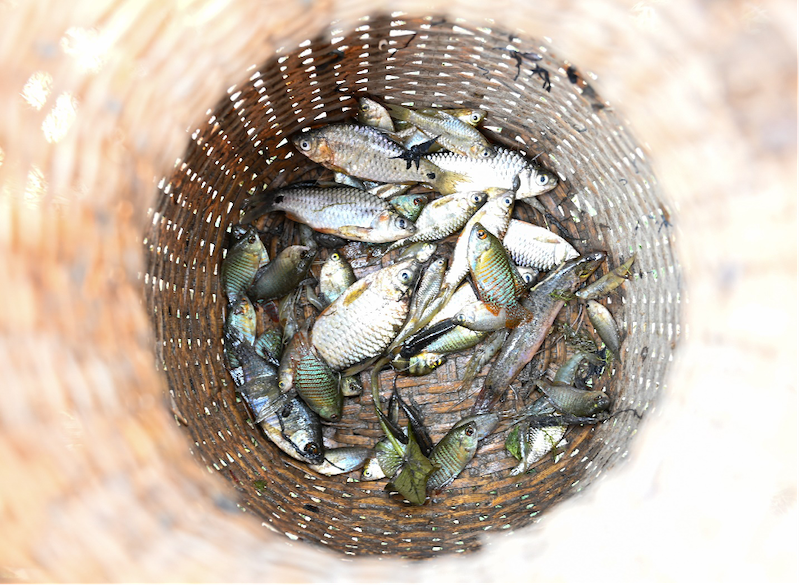
- Community fishing has significant cultural, livelihood and environmental implications for traditional communities in Northeast India with the Rabha community considering it as an activity that fosters camaraderie, togetherness and cultural ties among communities.
- The Rabha community’s fishing practice, known as Bahow, takes place at the Barjong beel in March, attracting thousands of people from different communities, where women constitute up to 60 percent of participants.
- While indigenous small fish species (SIS) are regarded as superfoods due to their high micronutrient content, which is essential for cognitive development and human health, SIS diversity is declining in parts of Assam, increasing their cost thus, making it less accessible to locals.
Indigenous fishing is a long-standing tradition that continues to be practiced today. Although it is primarily used for food and recreation, it has significant cultural, livelihood and environmental implications for traditional communities in Northeast India to the extent that community fishing has become ingrained in their local festivals, customs and culture.
In many of Assam's non-protected floodplain wetlands, hundreds of people from rural commons participate in community fishing. When the water in these wetlands – known locally as beel – recedes, the hunter-gatherers congregate in large numbers with traditional fishing tools to catch fish by trapping, hand-gathering and netting.
Barjong, a freshwater wetland of roughly 35 hectares, is located on the northern side of Barjong village in Goalpara district, southwest of Assam. It receives annual inflows from the Jinjiram River, a southern tributary of the mighty Brahmaputra River, which forms the natural boundary between Meghalaya and Assam.
The Barjong beel provides riparian communities with unique ecological services such as water storage, flood control, groundwater level regulation, agriculture and ritual chores. With a yield of about half a ton per hectare, this freshwater ecosystem supports diverse flora and fauna, including capture fisheries. Due to its ecological diversity, the Barjong beel is home to large populations of resident water birds, as well as threatened and endangered migratory birds.
The majority of Assam’s beels are either controlled by the government or run by the community. Since its inception in 2013, the Barjong beel has been managed by a grassroots institution, the Barjong beel Fisheries Committee (BFC). The BFC has been responsible for beel development, conservation, dispute resolution and community fishing. Every year, the BFC announces the date for community fishing while providing a prize for the largest catch.
Relying on traditional gears in a modern era

The Rabhas, an early indigenous tribal community of Assam, has a unique culture that is part of the larger Tibetan-Burman ethnic group with Indo-Mongoloid roots. Their traditional economy is built on agriculture and forest-related activities, and fishing is an important component of their social and recreational life.
The Rabha community’s fishing practice, known as Bahow, takes place at the Barjong beel in March, attracting thousands of people from different communities, where women constitute up to 60 percent of participants. Rabhas consider it as an activity that fosters camaraderie, togetherness and cultural ties among communities, as well as an opportunity for elders to pass along traditional fishing knowledge and skills to the new generation.
The event also draws thousands of onlookers. Fishing is done harmoniously without confrontation and every catch is celebrated with fishing hymns in the respective indigenous community’s native dialects.
Traditional fishing methods in Assam have been shaped by local ecological knowledge, enabling them to survive amid modern development and industrialization. Rabha and other tribal communities use various fishing methods during Bahow such as scooping, net lifting, plunging baskets, cast netting and spearing.
Fishing gears come in a variety of shapes and sizes, each tailored for a certain kind of fish. A quick survey identified nine types of indigenous fishing gears and traps, all of which were traditionally made from bamboo and locally accessible materials.
Women prefer lifting nets or porongi jal, whilst men favor plunging baskets such as polo and juluki. Women also commonly use scooping tools such as jakoi, chalonee, and khorahi.
Taking steps to restore species diversity

The assessment of the catch during Bahow identified 39 fish species, with over 70 percent being indigenous small fish species (SIS). While SIS are regarded as superfoods due to their high micronutrient content, which is essential for cognitive development and human health, SIS diversity is declining in parts of Assam, increasing their cost thus, making it less accessible to the locals.
Assamese cuisine features SIS in a variety of forms, including fresh, dried and fermented. Indigenous communities have long used SIS to make popular products such as hukan mas, shidol, hukati and namsing, which are believed to have medicinal and nutritional benefits.
“Species diversity in Barjong beel is declining, resulting in dwindling fish catch and affecting fishermen’s interest,” said Narendra Rabha, the secretary of BFC.
“Enthusiastic community participation and government support are critical to improving beel fisheries productivity and stock,” added Narendra.
The BFC intends to establish no-fishing zones in the Barjong beel to promote conservation awareness and make compliance with fishing regulations easier. The locals believe that when the first monsoon occurs, Bahow boosts productivity and does not harm the beel ecology. To reconcile ancestral rights, culture, livelihood and conservation, BFC advocates for the establishment of inclusive policies that include all stakeholders, particularly the community to promote ecological conservation and sustainable fisheries.
Acknowledgement
This project is funded by the German Federal Ministry for Economic Cooperation and Development (BMZ) and commissioned by the Deutsche Gesellschaft für Internationale Zusammenarbeit (GIZ) through the Fund International Agricultural Research (FIA).
Funded by



